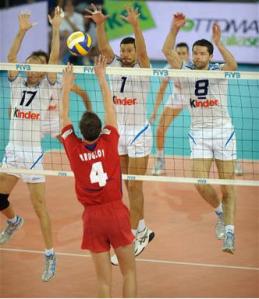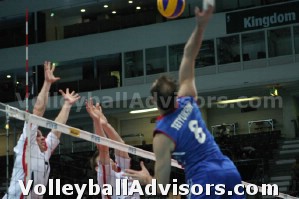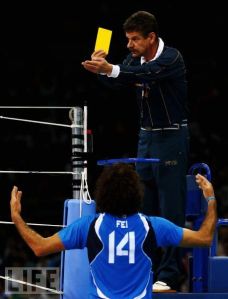Official Volleyball Rules - With Simple Language
Explore official volleyball rules in easy to understand format. Check also our volleyball rules cases, in which we present the rules in the real game situations, which help you to use rules to your advantage on the court.
To see the volleyball rules cases, go to the bottom of the Basic Volleyball Rules Section.
Official Volleyball Rules - in Easy to Understand Format
Volleyball player crossing the center line

Player is allowed to contact the opponent's court with the foot, if the part of the foot is on the own court side (either on the ground or above the court).
In other words stepping to the other side is a mistake, only if the whole foot is on the opponent's court side.
Switching volleyball positions
Players are allowed to switch the positions after the serve - they have to return to their own spot on the rotation after before the next serve.To read more about the positions, go to volleyball positions. You find them in the basic volleyball rules page.
Subs
According to international volleyball rules:Maximum of 6 subs per game is allowed.

Player who has entered the game can be replaced only with a player who s/he replaced (If player #12 replaces player #6, #12 can come back one more time for player #6). No more subs are allowed concerning player #6 or player #12 during the game.
In case the player is injured, he should be substituted legally. If subs are used team is entitled to a exceptional substitution.
Timeouts
Maximum of 2 time outs per game for a team is allowed. Time out lasts 30 seconds.In official international competitions two 60 seconds technical time-out are used when the leading team reaches the 8 or 16 point mark.
Official Volleyball Rules about Serving
Serve is performed by the player in position 1, the right back player. 
Serve can be performed by hand or any part of the arm. (Kick is not allowed in serving).
A ball has to be released from the hand before hitting it (common mistake, especially with underhand servers is to hit to ball without releasing the ball. However, remember that even quarter of an inch release is enough. It is correct as long as the ball is leaves the hand before hitting it.)
At the moment of the serve (or when jumping on the jump serve), the player has to be in the serving area.
In other words the player can not touch the back line or the ground outside the serving area. (For example jump server is not allowed to jump outside "the width of the backline".)
After the serve, the player is allowed to land or step on the court. (For example jump servers are allowed to land inside the court after serve).
Server has to hit the ball within 8 seconds after the whistle.
Only one toss is allowed. (In the past two tosses were allowed and the limit for each was 5 seconds)
More Official Volleyball Rules
Screening
Players of the serving team cannot form an individual or collective screen to prevent to receiving team from seeing the server of the path of the ball.Coach's position
Now coaches are allowed the stand up and guide the game. (Earlier they had to sit on the bench).Refereeing
Referee's hand signals: first referees show the side who won the rally, following by the reason of the judgment. (In the past it was other way around.)Yellow card:

Two yellow cards results the player has to leave the playing area and stay in the penalty area for remainder of the set.
Important:notice that the first "delay warning" does not result as a loss of rally. "Delay warning" is different from the regular yellow card. "Delay warning" is signaled by using yellow card -placing it towards palm of the up lifted hand.
In some leagues in United States first yellow card doesn't result a loss of rally.
Delays
Inappropriate requests and actions which delay the game are notallowed. 
For example illegal subs, prolonged subs or improper request are delaying the game. They result a delay "warning" or "penalty".
Those sanctions remain in effect to the end of the match.
Referee signals the delay "warning" or "penalty" by holding the yellow or red card on the hand - and placing it toward the palm of the other hand. Notice that the signals differ from the "regular" yellow or red card.
First delay offense per team results as a "warning". The second one, "penalty" results a loss of rally.
"Official Volleyball Rules" Related Pages
General Volleyball Rules
fivb.org - Official Rules
Rules of Volleyball - Cases "How to Use Rules to Win Points"
Don't forget to check our volleyball rules cases. Those cases help you to use rules in the match for your advantage.
Rules of volleyball - cases to win more points
Like this page:




